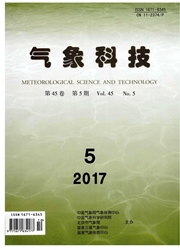

 中文摘要:
中文摘要:
利用常规气象观测资料、区域自动站加密观测资料和NCEP 1°×1°再分析资料,对山东2010年2月28日早春和2013年4月19日春季两次极端暴雪天气过程的环流形势和影响天气系统演变特征、水汽输送条件以及物理量场特征进行了对比分析。结果表明:1两次暴雪过程均受500hPa高空槽、700hPa切变线的影响,并有700hPa低空西南风急流配合;2暴雪区上空均有一条明显的能量锋区,并伴有逆温层,湿层深厚,垂直螺旋度呈上正下负的分布特点;强降雪落区位于水汽通量大值带左侧的水汽通量散度辐合中心附近;31.8km处冷空气活动是判断降雪结束的一个关键高度。不同之处在于:1"2·28"暴雪冷空气自东北楔入,暖湿气流被迫抬升,冷空气发挥主动作用;"4·19"暴雪之前一直维持东北风,形成冷垫,暖湿气流沿冷垫爬升,冷空气发挥被动作用;2"2·28"暴雪比"4·19"暴雪辐合上升运动出现的高度要高,上升运动的强度更强,不稳定层结更深厚。
 英文摘要:
英文摘要:
Based on the conventional observational,automatic meteorological observing station,and the NCEP 1°×1°reanalyzed data,two extreme snowstorms in Shandong on 28 February in 2010("2·28"for short)and 19 April in 2013("4·19")are comparatively analyzed.The results show that:(1)Both snowstorms were caused by the 500 hPa upper-level trough,low-level southwest jet,and shear line at 700 hPa.The differences are that the cold air came from northeast before the"2.28"snowstorm and forced the warm and wet air to climb,which played an active role,while there were northeast winds and a"cold pad"formed before the"4·19"snowstorm,and the warm air clam climbed along the pad,in which the cold air played a passive role.(2)There was an obvious energy frontal zone,inversion layer,and thick wet layer in both snowstorms.The vertical helicity has a distribution characteristic of positive at lower levels and negative at upper levels.The snowstorm area was located in the large water vapor flux area near the left side of the vapor flux divergence center.The difference lied in:comparing with the"4·19"snowstorm,the"2·28"snowstorm has a higher rising height of convergence,stronger ascending motion,and more profound and unstable stratification.
 同期刊论文项目
同期刊论文项目
 同项目期刊论文
同项目期刊论文
 期刊信息
期刊信息
